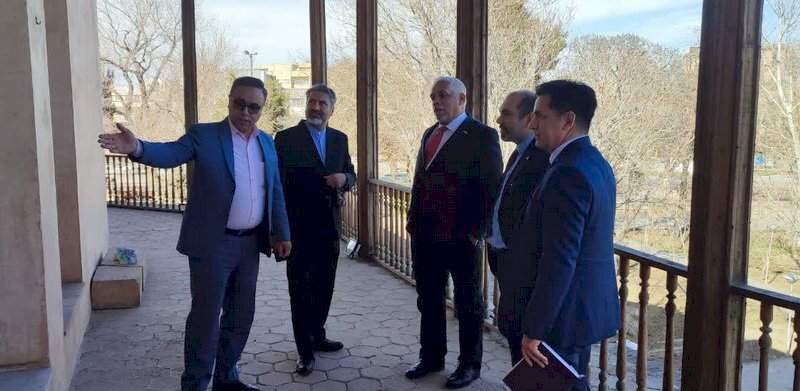Cuban ambassador visits tourist sites in Qazvin

TEHRAN – Cuban Ambassador to Iran Alberto González Casals on Tuesday visited some tourist attractions in west-central province of Qazvin.
He toured the Safavid-era (1501-1736) palace of Chehel Sotoun and the 19th-century bazaar of Sa’d-al Saltaneh amongst other sites, CHTN reported.
Chehel Sotoun is the only remaining palace from the royal palace of Shah Tahmasp (1524-1576) in Qazvin, with special historical importance, type of architecture, and decoration, which makes it a major tourist destination.
The monument was inscribed on the National Heritage list in 1948.
The interior of the building was radically altered in the Qajar period (1789-1925), but in the 1970s it was largely restored to its original appearance.
Restoration work in the 1970s revealed the remains of wall paintings on both levels. Upstairs, on the south wall of the western arm of the cruciform hall, there is a very lively representation of an individual wearing a European dress in the style of the 16-17th centuries.
Its Safavid and Qajar decorations are distinguishable: tiles, mostly of the Qajar period, on the exterior and both tiles and wall paintings from the original Safavid structure on the interior. The high quality of the surviving wall paintings suggests a date in the period when Qazvin was the capital.
The building consists of two stories. On the ground floor, a quadrangular central room communicates with the surrounding gardens through four iwans (porches), one on each side. Each iwan was originally connected to the central room by three short passages. The four corners between the iwans contain four rooms, each on a different plan.
On the exterior instead of corners, there are oblique walls, so that the plan is that of an unequal octagon. Around the exterior of the structure, eight massive columns and eight corner piers with engaged columns support a gallery encircling the upper story, which is reached via a bent staircase leading from the southeastern corner room.
Upstairs thirty-two slender wooden supports carry the roof of the gallery. The main portion of the upper story consists of a large cruciform hall, with four corner rooms, each with a small adjacent chamber.
Whereas the rooms on the ground floor and the iwans are vaulted, all the rooms on the upper story have flat wooden ceilings.
Sa’d-al Saltaneh bazaar is located adjacent to a beautifully restored Qajar-era caravanserai of the same name, which is one of the biggest roofed caravanserais in the country. Dating back to the Qajar era, it’s a place for discovering tens of Hojreh shops, cafes, yards, and a stunning mosque. It’s a place for visitors who want to experience the culture, cuisine, and hospitality of Iran.
Qazvin was once the capital of the mighty Persian Empire, under Safavids, from 1548 to 98. It is a major tourist destination with a wonderfully restored caravanserai-turned-arts precinct, some quirky museums and a handful of decent eating options. For most travelers, Qazvin is also primarily the staging point for excursions to the famous Castles of the Assassins and trekking in the sensational Alamut Valley.
Also known as the castle of the Assassins, the 12th-century Alamut castle is nestled on top of a peak. It was once a shelter for the followers of Hasan-e Sabbah (1070–1124) who was a spiritual leader of an Islamic sect. In the early 1930s, British-Italian explorer and travel writer Freya Stark described her exploration of the place in her book “The Valleys of the Assassins.”
ABU/

Leave a Comment